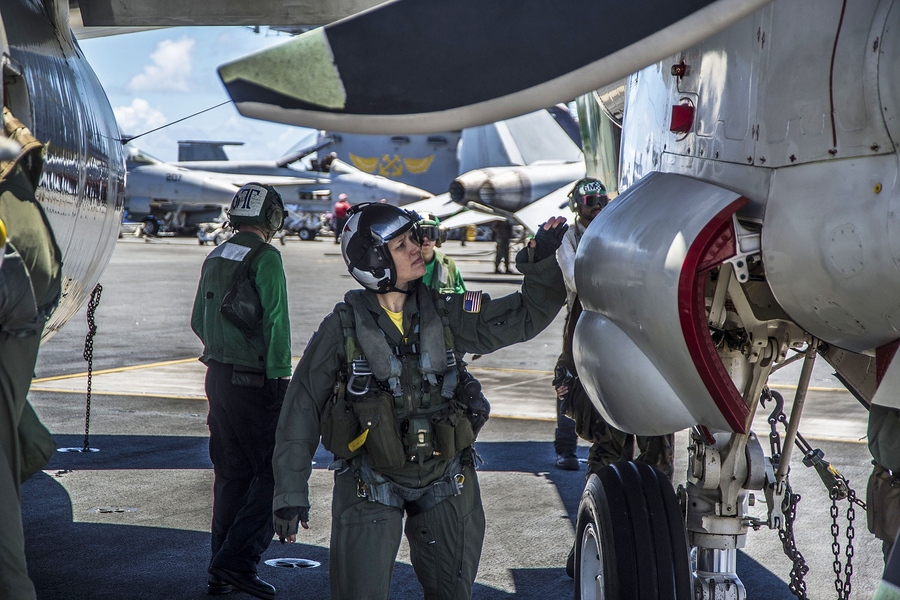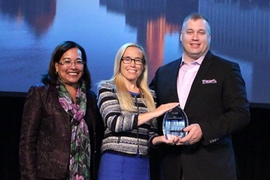For the past three years, the Department of Defense’s Naval Air Systems Command (NAVAIR) organization has committed to a different kind of mission than any it has pursued before — to transform their engineering acquisition capabilities to a model-based design. Their goal is to shorten the timeline from beginning to delivery without lacking quality or precision.
Since early in 2017, an essential part of implementing that transformation has been NAVAIR’s participation in the MIT program, “Architecture and Systems Engineering: Models and Methods to Manage Complex Systems,” a four-course online course on model-based systems engineering.
“It is taking way too long to develop and deliver the next generation of war fighting capability to our war fighters,” says David Cohen, director of the Air Platform Systems Engineering Department at NAVAIR, referring to the current design and development processes based on systems engineering practices and processes from the 1970s. “We need to shorten that timeline dramatically. We have a national security imperative to be delivering the next level of technology to our warfighter to continue to try to maintain our advantage over our adversaries.”
NAVAIR views the shift to model-based systems engineering as an essential step in shortening and modernizing its abilities to deliver high-quality, state-of-the-art programs. They enrolled their first cohort of 60 engineers and managers into the MIT program in March 2017. The third group will soon complete the four-month program, which has become a key piece of the NAVAIR transformation by building the awareness and skills needed to successfully implement model-based systems engineering.
Procuring naval aviation assets
NAVAIR procures and helps sustain all of the Navy and Marine Corps aviation assets — helicopters, jets, transport aircraft, bombs, avionics, missiles, virtually any kind of weapon used by U.S. sailors and Marines. Their responsibilities include research, design, development, and systems engineering of these assets internally and with contractors; acquisition, testing and evaluation of these assets, as well as training, repair, modification, and in-service engineering and logistics support.
“We are the organization that receives requirements from the Pentagon for a new program, puts them out on contract, does the acquisition of that project and also provides the technical oversight and programmatic oversight during the development of that project to be sure it is maturing as expected and delivering what is needed,” says David Meiser, Advanced Systems Engineering Department head, who is helping to lead the systems transformation effort at NAVAIR.
NAVAIR employs more than 10,000 engineers, plus logisticians, testers, and specialists in a variety of different areas from software, to engines, to structures.
“We are kind of like the FAA for naval aircraft,” says Meiser, referring to the Federal Aviation Administration. “We go through the whole test and certification process and also provide the air-worthiness authority. Once the system is tested and does what it needs to do, we also provide the support mechanism to have ongoing logistics and engineering support needed to maintain these aircraft for 20-50 years.”
Design changes needed
It takes approximately 15 years to build a new weapons system, such as a fighter jet, from idea to fruition. A key reason is due to increasing systems complexity. In the 1960s, the technology of a jet was largely based solely on the air vehicle itself. Today, everything is integrated with the aircraft ranging from how it flies, its targeting system, its weapons capabilities, the visual system, and more.
“They are so much more complex in functionality and capabilities and it’s harder to develop and manage all of the requirements and interfaces,” says Systems Transformation Director Jaime Guerrero of NAVAIR’s Systems Engineering Development and Implementation Center. “You need a model-based approach to do that as opposed to a document-centric approach which has been how NAVAIR has operated for decades.”
Add to the pressure that NAVAIR leadership was mandating a cycle time collapse from 15 years to less than half that, David Cohen says.
“That’s where we need to be,” Cohen adds. “The threats we are trying to address with these weapons systems are evolving in a faster pace. We have to be a lot more agile in terms of getting a product to the fleet much faster.”
In 2013, NAVAIR participated in a research effort with the DOD’s Systems Engineering Research Center (SERC) to learn how to find better and faster ways of systems engineering. After collaborating with industry partners, academia, and other government agencies, SERC determined that is was technically feasible to pursue modeling methods as the way forward in the future. Between 2014 and early 2016, NAVAIR engineering leadership researched modeling methods with its key industry partners like Boeing, Lockheed Martin, Raytheon, and 30 other companies to see how they were executing model methods, as well as those practiced in the auto industry where short design timelines are the norm. They also enlisted input from other government agencies that were already moving their processes to a model-centric method.
“We absorbed a lot of information from these industries to see that we could use a different methodology to collapse cycle time,” Guerrero says.
In those two years, NAVAIR researched 40-50 companies, universities, and government agencies and decided it was technically feasible for them to transform in about 10 years to be a different organization with different skills, tools, methods, and processes. They made the commitment to shift to model-based system engineering to incorporate this paradigm shift into its organization.
Implementing model-based systems engineering
Leadership, however, was not supportive of a 10-year transformational window. They wanted to aggressively compress the timeline.
“When we realized leadership wanted to compress the timeline to about a three-year timeline for transforming the organization, we decided to go out and search experts and the best training we could get, the best tools in the market,” Guerrero recalls.
They started searching for the resources needed to do that and attended workshops and symposiums. One of them was sponsored by NASA’s Jet Propulsion Laboratory, which was a few steps ahead in initiating a model-based systems engineering (MBSE) perspective. There, Meiser, and Guerrero learned of the MIT program from Bruce Cameron, director of the Systems Architecture Lab at MIT, who developed the coursework in 2016 and was also in attendance.
“Some of our partners, especially Boeing, were already involved with the MIT coursework and they recommended it,” says Guerrero. It had also become a command initiative at NAVAIR to push a fast transformation program. “So we had the command initiative and the resources to go out and train as many people as possible,” he says.
NAVAIR committed to the courses as a way to establish a common language, to introduce its workforce to concepts, tools, and terminology that will foster deeper conversations that are going to be necessary to adopt MBSE concepts and advance the level of training.
The entire four-course online program, which runs on the edX online learning platform, requires about 20 weeks for completion. Each course is gated with a weekly lesson which requires about 4-5 hours of work/week. It has a combination of videos, reading material, assessment and course work. At the end of each week, students are required to complete a project which is reviewed by peers.
When Guerrero and Meiser completed the program in the spring of 2017, they realized it would help align NAVAIR’s leadership by educating its command leaders why modeling is part of the solution for them to become a more agile organization.
“The four-course series provides a high-level explanation of how to do systems engineering and architecture in a model-based environment, Meiser says. “At the end of these courses you may not be a total practitioner of model-based engineering but you have an appreciation of the value of model based methods.”
Management commitment from top leadership
“We came out of that and realized we needed to require a lot of our senior leaders here and some of our chief engineers because it is not about making them modelers or making them experts in the process,” adds Guerrero. “It’s about informing them of how this model-centric method is going to help us as an organization. Leaders have to be in agreement and push in the same direction to make this quick transformation happen.”
Fortunately, NAVAIR’s top leadership was immediately on board.
“What we have going for us at NAVAIR is that they’ve embraced MBSE and faster cycle times as a command initiative and they’ve committed to doing this comprehensively across NAVAIR,” says Meiser, adding they’ve been given the budget to pursue MBSE and top-level support.
Vice Admiral Paul Grosklags, NAVAIR commander, even prepared a video discussing the path to going digital with acquisition, sustainment, and business processes and how it has the potential to increase readiness and speed to the fleet. Encouraged by that, Guerrero and Meiser produced their own YouTube video to help get the message out about the systems engineering transformation at NAVAIR.
As a result, NAVAIR targets the MIT program toward management and command leaders across all of its engineering disciplines as well as logistics and testing, the people who have to facilitate the change. Though they are not the individuals responsible for doing the modeling, they are required to understand the capabilities of model-based systems engineering.
Now that nearly 150 NAVAIR personnel have completed the program, the feedback has been very encouraging. Some with more experience believe it was a great reinforcement of what they knew or should have known. Others say it helped them understand certain MBSE aspects they were not previously familiar with.
“We’ve given it to a fairly diverse group of people,” says Meiser. “One thing I had heard regularly is that people say once they’ve been through it that they look at the problem differently. That has been the effect we’ve wanted to have. They start to think more about how to approach the problems in a model-based approach.”
Participants have also realized the value of pursuing this type of education together in the MIT program.
“We have learned from others NOT to try to do this transformational work in isolation,” adds Meiser. “This discipline is fairly new and having access to others pursuing the same thing has been very helpful for us.”
The leadership perspective
Cohen appreciated the non-intrusive delivery method as well as the content, feeling that the on-site training provided a good balance of depth and instruction time. “It has been an integral first step, especially for bringing the broad workforce at large into the discussion of what MBSE is,” he says.
Cohen knows NAVAIR is embarking on a monumental challenge. After completing the program himself, he realized he had to adjust his expectations.
“It helped alert me to some of those cautionary areas where I could be considered more optimistic about my expectations,” he says. “Throughout the course, there was more emphasis on quality of the product, not just on rapid cycle time.”
He was particularly impressed by the level of respect, knowledge, and professional experience demonstrated by others involved in the course.
“I had to take on board and value the experience of people who have been working in this field a lot longer than we have,” he says. He admits the coursework tempered his aggressive expectations, but it simultaneously highlighted where NAVAIR needed to invest more research and resources in certain program areas to achieve the faster results expected by top leadership.
Cohen credits the program with shaping the transformational process at NAVAIR by pointing out where they need to pursue deeper dives for the next level of depth in workforce training.
“The course gives you the understanding that MBSE has layers to it,” he says. “So depending on where you are in the organization, you will need to get more in-depth training in your area. We found the course introduced everyone to the depth and breadth of what model-based engineering is, its applications and how it’s used.”
At NAVAIR, the program has worked because they intentionally involve a large diversity of people across the organization rather than a few silos involving an entire group or department. They recommend that the program be taken by those in higher levels of an organization who are facilitating the engineering change. Those with more job-specific responsibilities should receive training specific to those precise areas they are going to be implement.
“The courses have helped everyone understand the over-arching goal and establish a common language,” says Cohen. “Although the transition to model-based systems engineering is complicated, we have expanded our skills and contacts tremendously in the process and crystalized where we need to focus on to get results.”










